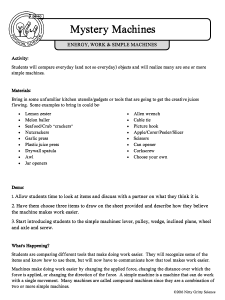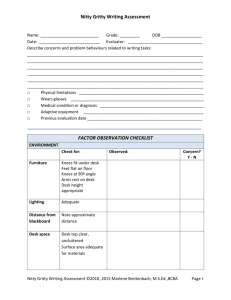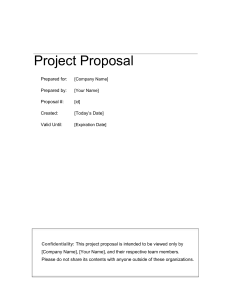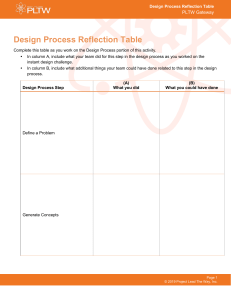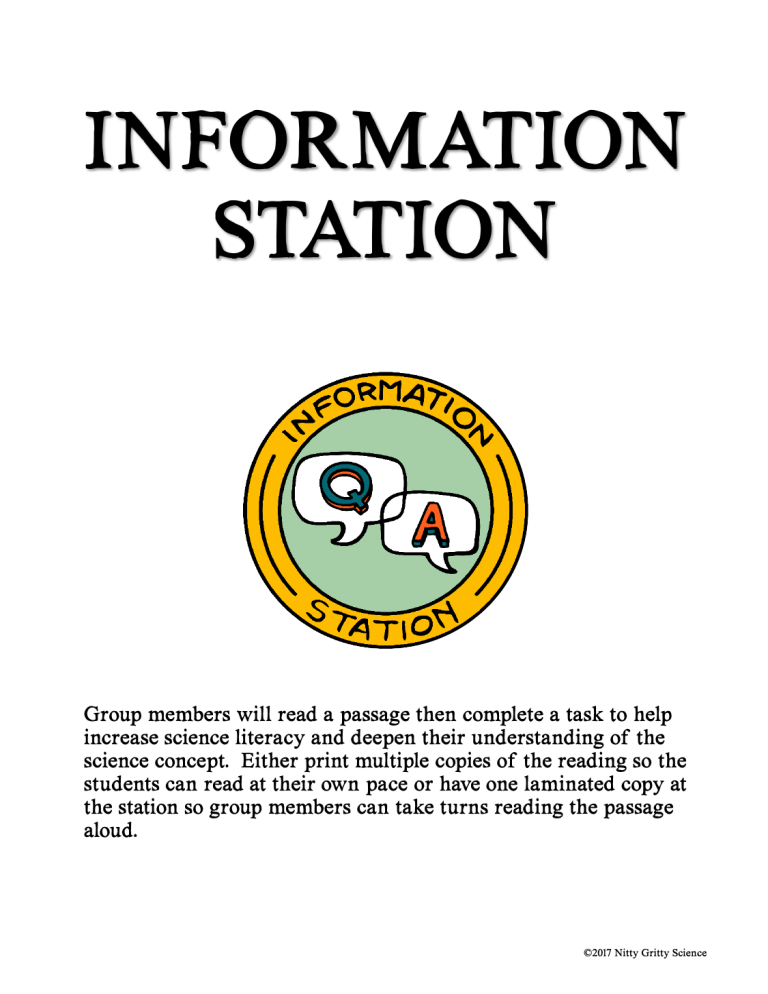
INFORMATION STATION Group members will read a passage then complete a task to help increase science literacy and deepen their understanding of the science concept. Either print multiple copies of the reading so the students can read at their own pace or have one laminated copy at the station so group members can take turns reading the passage aloud. ©2017 Nitty Gritty Science The Elements of Diving Scuba diving is a water sport enjoyed both recreationally and professionally. Scuba diving allows you to explore the ocean at a greater depth and for a longer period of time than just swimming or snorkeling. Scuba divers carry a special tank with them which allows them to breathe under the water. Their tank contains air, called compressed air, which allows them to explore freely. The tanks that scuba divers wear when diving need to be filled with certain types of air in order to ensure proper safety. The further down scuba divers swim in the ocean, the greater the pressure is on their bodies. The air pressure gets very heavy and can cause bodily pain, especially in your ears. The increased pressure also affects how we breathe. Divers take in more air as they dive deeper, which can lead to more nitrogen absorbed in our body. The increase of nitrogen in our bodies cause bubbles in our body which can “pop” as we come up for air, leading to pain in our joints and other possibly fatal injuries. For both recreational and professional divers, they need to use a specific type of gas in their tanks. Two common types of gases are nitrox and heliox. Nitrox is a mixture of over three quarters nitrogen and one quarter oxygen. This has more oxygen than what is in our normal air. This type of gas mixture is beneficial for recreational divers because it allows for longer dive periods, and reduces some of the decompression sickness and fatigue to your body. However, you can not go as deep with this mixture due to a problem called oxygen toxicity, which is when you inhale oxygen in high concentrations for an extended period of time. This condition can lead to seizures and drowning. Heliox is another gas most commonly used by professionals who wish to explore even greater depths of the sea. Helium, which is the main gas in this mixture, combined with oxygen, does not contain the side effects of nitrogen, and can also help you breathe easier. However, heliox is expensive, has a limited availability and can cause the diver to lose body heat up to six times faster than those divers using nitrox, which can lead to hypothermia. Professional divers can use heated heliox in their tanks or wear suits filled with hot water to prevent the hypothermia. With this type of gas, divers need a second tank of air or nitrox for when they are exploring very shallow areas of the sea. To date, less than five percent of the world’s oceans have been explored. With proper training and equipment, you may one day dive yourself and help uncover the mysteries of our planet’s greatest resource. ©2017 Nitty Gritty Science A B Identify some risks of scuba diving in regards to air? Define oxygen toxicity and explain how it occurs in scuba diving? ©2017 Nitty Gritty Science ©2017 Nitty Gritty Science C D What is one major drawback to using heliox when scuba diving? To date, approximately how much of the ocean has not been explored? ©2017 Nitty Gritty Science ©2017 Nitty Gritty Science OBSERVATION STATION Group members will have images, illustrations or actual samples at this station that show applications or processes of the science topic. Using what they’ve learned, they will need to apply their observation skills to complete the questions attached to each. Print and laminate provided pictures or illustrations for students to rotate. ©2017 Nitty Gritty Science A Every living organism has isotopes of carbon. Two particular isotopes, carbon-12 and carbon-14, are used to determine the age of organisms that may have died in the past. When a living organism dies, it stops taking in new carbon. Carbon-14 will start to decay, while carbon-12 remains constant. 1. How can carbon-12 and carbon-14 help archeologists discover the age of this fossil? 2. A scientist discovers a meteorite. Can she use carbon dating to identify the age? Explain your answer. ©2017 Nitty Gritty Science B 1. What element is used to make this sign? 2. What periodic table group can this element be found in? What are some properties of this group? ©2017 Nitty Gritty Science C 1. Recent Federal Drug Administration statements advise limiting a person’s intake of tuna and other fish because of what transitional element? 2. Explain why this element poses a potential risk. ©2017 Nitty Gritty Science INVESTIGATION STATION Group members will work with one another to explore the concept through hands-on activities so they may practice specific inquiry process skills as they learn. ©2017 Nitty Gritty Science Table of Elements Problem: How can you determine the arrangement of elements based on mass and properties? Materials: • • • • glue stick scissors premade element cards colored pencils/crayons Procedure: 1. Cut out the premade element cards. 2. Arrange the element cards onto the blank table on your answer sheet in order of increasing mass. Take care to place each card based on its properties. Leave gaps if necessary. 3. When you feel the cards are arranged properly, glue them in place. 3. Answer the following questions in your lab notebook under your table. Analyze and Conclude: 1. Observe the color pattern you see in your table. Explain the configuration in both the periods (rows) and groups (columns). 2. Explain how you arranged your elements according to their mass what trends do you see in both the periods and groups? 3. You’ve just discovered an element that is a magenta gas. Which group would you expect it to be added to? 4. You have just discovered a new element, using the blank element card fill in the missing information and glue it onto the final gap. ©2017 Nitty Gritty Science Orange Light Blue Bc Red Bn Light Green Solid/Liquid 53.7 Ductile Solid 106.8 Gas 69.5 Brittle Solid 113.0 Pink Green Navy Blue Pale Yellow Gas 102.2 Brittle Solid 82.3 Ductile Solid 67.2 Liquid 104.5 Dark Green Crimson Zt Blue Me Brittle Solid 61.1 Gas 47.0 Ductile Solid 97.6 Orange Light Blue Bc Red Bn Light Green Solid/Liquid 53.7 Ductile Solid 106.8 Gas 69.5 Brittle Solid 113.0 Pink Green Navy Blue Pale Yellow Gas 102.2 Brittle Solid 82.3 Ductile Solid 67.2 Liquid 104.5 Dark Green Crimson Zt Blue Me Brittle Solid 61.1 Gas 47.0 Ductile Solid 97.6 An Fn Uh An Fn Uh Ns Ns Pi Pi Cz Sq Cz Sq ©2017 Nitty Gritty Science CALCULATION STATION Group members use their math skills to complete the station challenge. Skills may include graphing, analyzing data, using models, measurement, and calculating formulas or word problems. ©2017 Nitty Gritty Science Using the Periodic Table The periodic table of elements was created by Dmitri Mendeleev, a Russian chemist searching for a way to organize the elements. He discovered a way to arrange the elements by increasing atomic number and by changes in physical and chemical properties. Materials: none Procedure: 1. Complete the table by filling in the missing information. You may use a periodic table if necessary. Element Name Chemical Symbol Nickle Atomic Number Number of Neutrons Number of Protons Atomic Mass 28 30 28 58 5 4 9 34 79 47 108 Beryllium Be Selenium Se 34 Ag 47 61 Neodymium Nd 60 84 Tungsten W Copper Cu 29 Sulfur S 16 Californium Cf 98 153 10 10 Neon 144 110 74 35 29 16 184 32 251 10 20 ©2017 Nitty Gritty Science COMMUNICATION STATION There are three different options for this station: interviews, video, or group essay. Depending on the option you choose, group members will communicate what they know by answering questions in creative ways. Print and laminate questions and place them in envelope (if appropriate). If you decide to run this station as an interview station, this is a good place for you as the teacher to take the role of the interviewer and ask the questions so you can get a quick formative assessment to see if the students are understanding the material. ©2017 Nitty Gritty Science A B Define the general properties of metals which make them useful and versatile materials. Classify each of these elements as a metal, nonmetal, or metalloid and gie the full name of each: K, Si, Ba, and S ©2017 Nitty Gritty Science ©2017 Nitty Gritty Science C D Explain how Dmitri Mendeleev organized the periodic table of elements. How did Henry G.J. Moseley improve it? Explain why the atomic mass of an element is the average atomic mass? ©2017 Nitty Gritty Science ©2017 Nitty Gritty Science A B A: Metals are good conductors of heat and electricity, typically solid at room temperature. They are malleable and ductile. A: K, potassium, metal; Si, silicon, metalloid; Ba, barium, metal; S, sulfur, non-metal ©2017 Nitty Gritty Science ©2017 Nitty Gritty Science C D A: Mendeleev organized the elements using increasing atomic mass and chemical and physical properties. Moseley arranged elements based on atomic number (number of protons). A: Elements have several isotopes with different number of neutrons, and thus different masses. The average atomic mass is the weighted average of the masses of isotopes. ©2017 Nitty Gritty Science ©2017 Nitty Gritty Science CREATION STATION Group members will work together to solve a STEM (Science, Technology, Engineering, Math) challenge by creating models or designs that demonstrate their understanding of the science topic being taught. Students will place completed projects in a specified location until the entire class is ready to test their designs. Testing: I recommend setting aside time to test all projects as a class and having each group record their data on their answer sheet and on a class data table. This not only helps with class management, but also lends itself to some friendly competition among your different sections. ©2017 Nitty Gritty Science Bohr’s Models Challenge: Create a Bohr’s model of an element showing the proper number and placement of each atomic structure. Materials: • • • • • • red paper circles blue paper circles yellow paper circles glue sticks large poster paper markers Model Requirements: 1. Each team will create a Bohr’s model of an atom that will be displayed in or around the classroom. 2. Groups must choose an element from the envelope provided. 3. Draw a Bohr’s model of the element you chose on your answer sheet. Once everyone in the group has determined the model is correct, use the materials to create a poster-sized model. 3. All models must conform to each other, therefore use the following guidelines: - red paper circles – protons blue paper circles – neutrons yellow paper circles – electrons diameter of the nucleus is 10 cm each electron orbit (shell) is 10 cm from the nucleus and one another 4. On your poster paper, NEATLY write the name of your element and make of key of how many protons, neutrons, and electrons the element has. 5. Display the poster in the area your teacher has identified. ©2017 Nitty Gritty Science IMAGINATION STATION This station is to act as a closure activity. All students complete this station at the same time, for example by you projecting the task on a screen. This station makes science concepts relevant for students by asking them to complete tasks that will bring about discussion and critical thinking. To complete station, give students a few minutes to complete task individually, then ask students to share out. This station is not intended to be graded for correct or incorrect answers, but instead be used as an approach to give students awareness of the science topic in the world around them. ©2017 Nitty Gritty Science A Lightweight Idea Directions: Use your imagination to answer the statement below. IMAGINE you are at a bike race and notice that the bike frames were made out of a light and strong magnesium alloy. If you had access to a super strong and lightweight metal, what would you create with it? ©2017 Nitty Gritty Science STUDENT ANSWER SHEETS Name _________________________________________________________ Date ___________ A1. _________________________________________________________________ _________________________________________________________________ A2. _________________________________________________________________ _________________________________________________________________ B1. _________________________________________________________________ _________________________________________________________________ B2. _________________________________________________________________ _________________________________________________________________ C1. _________________________________________________________________ _________________________________________________________________ C2. _________________________________________________________________ _________________________________________________________________ A. _____________________________________________________________ _____________________________________________________________ _____________________________________________________________ B. _____________________________________________________________ _____________________________________________________________ _____________________________________________________________ C. _____________________________________________________________ _____________________________________________________________ _____________________________________________________________ D. _____________________________________________________________ _____________________________________________________________ _____________________________________________________________ 1 ©2017 Nitty Gritty Science Name _________________________________________________________ Date ___________ Directions: Organize and glue elements below. Analyze and Conclude 1. ___________________________________________________________________________________________________________________ ___________________________________________________________________________________________________________________ 2. ___________________________________________________________________________________________________________________ ___________________________________________________________________________________________________________________ 3. ___________________________________________________________________________________________________________________ ___________________________________________________________________________________________________________________ 4. ___________________________________________________________________________________________________________________ ___________________________________________________________________________________________________________________ 2 ©2017 Nitty Gritty Science A1. Name _________________________________________________________ Date ___________ _________________________________________________________________ _________________________________________________________________ A2. _________________________________________________________________ B1. B2. C1. C2. _________________________________________________________________ _________________________________________________________________ _________________________________________________________________ _________________________________________________________________ _________________________________________________________________ _________________________________________________________________ _________________________________________________________________ _________________________________________________________________ _________________________________________________________________ Directions: Complete the table. Element Name Chemical Symbol Nickle Atomic Number Number of Neutrons Number of Protons Atomic Mass 28 30 28 58 5 4 9 34 79 47 108 Beryllium Be Selenium Se 34 Ag 47 61 Neodymium Nd 60 84 Tungsten W Copper Cu 29 Sulfur S 16 Californium Cf 98 153 10 10 Neon 144 110 74 35 29 16 3 184 32 251 10 20 ©2017 Nitty Gritty Science Name _________________________________________________________ Date ___________ Sketch Bohr’s model below: Element: _________________________________ Protons: ____ Neutrons: ____ Electrons: ____ 4 ©2017 Nitty Gritty Science Teacher Guide & Answer Key INFORMATION STATION A. B. C. D. Risks associated with diving include increased pressure on body allowing more nitrogen in our body, which if not decompressed properly cause bubbles that lead to pain, and other injuries or even death. Oxygen toxicity in when you inhale high concentrations of oxygen for an extended period of time. This is caused by divers using nitrox, a mixture of nitrogen and oxygen. Helios causes divers to lose body heat up to six times faster than normal. Could cause hypothermia if not wearing proper equipment. 95% of the worlds oceans have yet to be explored. http://oceanexplorer.noaa.gov/technology/diving/technical/technical.html http://www.leisurepro.com/blog/scuba-guides/3-types-scuba-diving-air-mixes/ https://www.sciencenewsforstudents.org/article/pressure-scuba-diving http://www.lakesidepress.com/pulmonary/books/scuba/sectionl.htm OBSERVATION STATION A1. Since carbon-14 decays – scientists can compare the amount of carbon-14 to the amount of carbon-12 to determine the age of the organism. A2. Carbon dating only works on objects that were alive at one point. The scientist would need to find another method to find the age of the meteorite. B1. Neon B2. Found in the noble gases which exist as isolated atoms. They are stable because their outer energy levels are full. C1. Mercury C2. Mercury is poisonous to both land and marine organisms. Over time it accumulates in small fish that live in contaminated water, which poisons tuna and other larger fish that consume them. ©2017 Nitty Gritty Science Teacher Guide & Answer Key COMMUNICATION STATION A. Metals are good conductors of heat and electricity, typically solid at room temperature. They are malleable and ductile. B. K, potassium, metal; Si, silicon, metalloid; Ba, barium, metal; S, sulfur, non-metal C. Mendeleev organized the elements using increasing atomic mass and chemical and physical properties. Moseley arranged elements based on atomic number (number of protons). D. Mendeleev organized the elements using increasing atomic mass and chemical and physical properties. Moseley arranged elements based on atomic number (number of protons). CREATION STATION Note: Cut up a periodic table and use elements 1-15. Allow students to use their periodic table to assist them. Prepare ahead of time using dicut machine or craft punch (depending on class size): 150 – 3 cm circles from red paper 150 – 3 cm circles from blue paper Using a small hole punch: 150 – circles from yellow paper Poster paper that will allow some groups to make 3 electron levels from nucleus. (40 cm total from center of paper). IMAGINATION STATION Answers will vary, but students should understand that the future of metal is always looking for stronger, lighter material. Airplanes, armor suits, building supplies, etc. ©2017 Nitty Gritty Science Teacher Guide & Answer Key CALCULATION STATION Element Name Chemical Symbol Atomic Number Number of Neutrons Number of Protons Atomic Mass Nickle Ni 28 30 28 58 Beryllium Be 5 5 4 9 Selenium Se 34 45 34 79 Silver Ag 47 61 47 108 Neodymium Nd 60 84 60 144 Tungsten W 74 110 74 184 Copper Cu 29 35 29 64 Sulfur S 16 16 16 32 Californium Cf 98 153 98 251 Neon Ne 10 10 10 20 INVESTIGATION STATION 1. The color wavelength decreases going across the row (period) and the color becomes lighter moving down the column (group). 2. The mass of the elements increase both across the period and down the groups. 3. A magenta gas would most likely be placed in Group 1 4. The newly discovered element will be a yellow liquid with a mass between 70 and 80 grams. Crimson Orange Dark Green Navy Blue Gas 47.0 Solid/Liquid 53.7 Brittle Solid 61.1 Ductile Solid 67.2 Zt An Uh Pi Red Green Ns Me Gas 69.5 Brittle Solid 82.3 Ductile Solid 97.6 Light Blue Bn Blue Pink Pale Yellow Light Green Fn Sq Cz Bc Gas 102.2 Liquid 104.5 Brittle Solid 113.0 Ductile Solid 106.8 ©2017 Nitty Gritty Science

